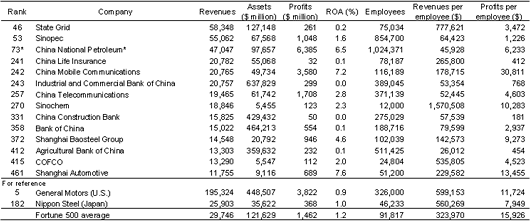Fourteen Chinese companies have made their way into the list of "2004 Global 500" released in July by the U.S. business magazine Fortune. Among them, State Grid, Shanghai Baosteel Group and Shanghai Automotive have shown up for the first time. The other 11 firms that rank among the top 500 for the second straight year are Sinopec, China National Petroleum, China Life Insurance, China Mobile Communications, Industrial Bank of China, China Telecommunications, Sinochem, China Construction Bank, Bank of China, Agricultural Bank of China and COFCO ( table ). However, these are all state-owned enterprises that are protected by government regulations and have a strong monopoly in their respective fields. Many non-state owned enterprises that have been showing remarkable growth in recent years have yet to appear among the ranks of the top companies in the world.
Although all these fourteen companies are huge, there is still a large gap between them and top corporations of the world in terms of productivity and/or profitability. One good example is the four major state-owned banks, which are straddled with massive workforces and huge amounts of non-performing loans. Despite repeated infusions of public funds to dispose of non-performing loans and shore up their capital base, their profitability has remained at very low levels. Indeed, the four major banks would be in negative net worth without preferential treatments and financial support by the government.
Meanwhile, Shanghai Baosteel Group and Shanghai Automotive have become the first Chinese manufacturers to make the "Global 500," and this has drawn attention in China as a symbolic feat showing that the nation is indeed rising as the world's factory. However, it is clear there is still a huge gap between Chinese manufacturers and their counterparts overseas.
Shanghai Automotive, which is ranked 461st overall, is placed 32nd among the world's automakers, but its revenues are a scant 6% that of industry leader General Motors Corp. Furthermore, most of the cars produced by Shanghai Automotive are through joint ventures with Volkswagen and General Motors, and it does not have the ability to develop or manufacture products on its own. Despite this, its return on revenues and return on assets (ROA) are ranked 4th and 1st, respectively, among the world's automakers, thanks to the special circumstance that the Chinese auto market is protected by high import tariffs. In fact, Chinese automakers, including Shanghai Automotive, still lack internationally competitive and their products, once exported out of China, cannot match those of their rivals.
Meanwhile, Shanghai Baosteel Group, which is ranked 372nd overall, is placed 7th among the world's steel makers. While its profitability is comparatively high, its labor productivity is much lower than that of its competitors. For example, compared to Nippon Steel Corp., the industry's No. 2 firm, Shanghai Baosteel has 2.2 times as many employees but only 56.2% of revenues, and revenues per employee stand at just 25.5% that at Nippon Steel. In contrast, profit per employee is greater than that of Nippon Steel. The reason for the coexistence of low productivity and high profitability is the lack of market competition, thanks to the government's industrial policies.
Many Chinese firms that have successfully competed in international markets such as Haier are striving to join the rank of "Global 500." While it goes without saying that it is necessary to improve corporate governance in order to achieve this goal, there are many other hurdles to overcome, such as the need to break down the monopolies of state-owned enterprises and provide a level playing field for non-state-owned firms.
 click on graph to enlarge
click on graph to enlarge
*The magazine later corrected China National Petroleum's rank to 52nd (2nd amog Chinese firms)
(Source)2004 Global 500 Fortune , July 26, 2004


